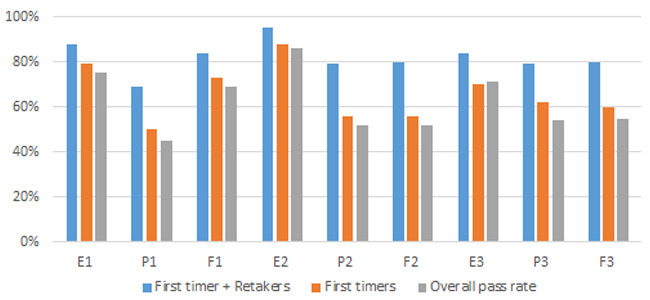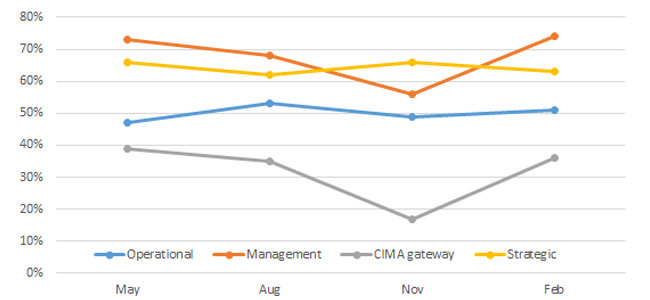- You are here:
- Home »
- Blog »
- CIMA Exam »
- CIMA Exam Pass Rates 2019: How the Statistics Affects Your Chance of Success
CIMA Exam Pass Rates 2019: How the Statistics Affects Your Chance of Success
There are official release of the CIMA exam pass rates. In this post, we attempt to analyze these data and give meaning to these statistics — what is the trend, and how does it affect you as a candidate?
(CIMA in this website refers to Chartered Institute of Management Accountant. For Certified Investment Management Analyst, please click here.)
CIMA Exam Pass Rates – Objective Tests
As you may know, there are three levels of the CIMA exam in the Professional Qualification program:
- Operational (Level 1)
- Management (Level 2)
- Strategic (Level 3)
In each of these level, there are three tests from each of the learning pillars (i.e. exam topics):
- Enterprise pillar
- Performance pillar
- Financial pillar
For example, E1 is the Enterprise pillar exam in the first operational level. F3 is the Finance exam in the third Strategic level.
Below is the CIMA exam pass rates for the 9 objective tests:
| E1 | P1 | F1 | E2 | P2 | F2 | E3 | P3 | F3 | |
| First timer + Retakers |
88% | 69% | 84% | 95% | 79% | 80% | 84% | 79% | 80% |
| First timers | 79% | 50% | 73% | 88% | 56% | 56% | 70% | 62% | 60% |
| Overall pass rate |
75% | 45% | 69% | 86% | 52% | 52% | 71% | 54% | 55% |
Let’s take a closer look at each of the CIMA exam pass rates:
CIMA E2 Pass Rate was the Highest
In fact, E1, E2 and E3 all have higher pass rates than the other pillars. What does E (Enterprise) cover, and why do candidates perform better?
The Enterprise pillar focuses on how to formulate as well as effectively implement strategy. It emphasises how change management, project management and relationship management and the structuring of organisations can help to successfully implement strategy – CIMA website
Therefore, this learning pillar is more on how professionals handle and manage relationships in the form of a project or a working team. It relies more on common sense and practical experience, and less on technical skills (e.g. accounting knowledge) when compared to other learning pillars.
When you study for the E1, E2 and E3 exams, keep this in mind and you will do well like most of the others.
CIMA P1 Pass Rate was the Lowest
The Performance pillar exams (P1, P2 and P3) performed the lowest in every level. The contrast was especially big in the first Operational level.
The Performance pillar uses the tools and techniques of management accounting and risk management to ensure a realistic strategy and to monitor implementation. It covers budgets and cost management and develops the ability to identify, classify, evaluate and manage risk.
It is true that many candidates, even those with accounting training, are scared of management accounting. Also, given management accounting is the core of CIMA, the standard is probably higher, thus making the exam more difficult.
First Timer Pass Rates > 50%
The CIMA exam pass rates for the objective tests were actually quite high. In particular, passing rates among first timers were above 50%, and mostly above 60%. This is in fact a very encouraging level among global accounting exams.
Even if the candidate fails, if he is persistent to try again, the chance of making it in the end is very high with an average percentage above 80%.
CIMA Exam Pass Rates – Case Studies
Besides the 9 Objective Tests, CIMA candidates need to take one integrated case study exam in each level. As the name suggests, this test is meant to integrate the three learning pillars.
The CIMA exam pass rates in the last 4 quarters are shown below:
| May | Aug | Nov | Feb | |
| Operational | 47% | 53% | 49% | 51% |
| Management | 73% | 68% | 56% | 74% |
| CIMA gateway | 39% | 35% | 17% | 36% |
| Strategic | 66% | 62% | 66% | 63% |
CIMA Pass Rate Analysis
1. Operational Level
The Operational pass rate has been relatively consistent, ranging from 47 to 51%. The pass rate is in line with that in the US CPA exam (around 50%).
2. Management Level
Interestingly, the overall CIMA exam pass rates in this second level are more than 10%-point higher. This is significant, and encouraging to those who passed the Operational level.
One theory is that those who are eligible to take the second level exams are usually more dedicated and more prepared. The ones who are not have been screened out in the first level. We see the same trend in CFA’s 3 level exams.
3. Strategic Level
The CIMA exam pass rates in this last level ranges from 62% to 66%. It seems to be similar or slightly lower than the Management Level performance. The questions are more difficult but the overall passing rate at 60s is in fact quite good.
CIMA Gateway
For those with an MBA or a Master’s in Accounting degree, you can choose to take the CIMA Gateway exam. If passed, you will be seen as equivalent to passing the Operational and Management levels, and can go straight to the last i.e. Strategic level.
The CIMA Gateway pass rate was the lowest among all exams. This is not surprising because having a master’s degree doesn’t necessarily translate into better exam takers in the CIMA exam. I imagine there are quite a few “casual exam takers”, trying their luck and see if they are able to skip the first two levels. If you are one of these people, have a second though. The CIMA Gateway is a great path for those who are prepared, but it may not be for everyone.
For Your Further Reading
Comparison:
More information on the CIMA exam:
If you have any other questions, please drop a note in the comment section below. Thank you!
About the Author Stephanie Ng
I am the author of How to Pass The CPA Exam (published by Wiley) and the publisher of this and several accounting professional exam prep sites.


